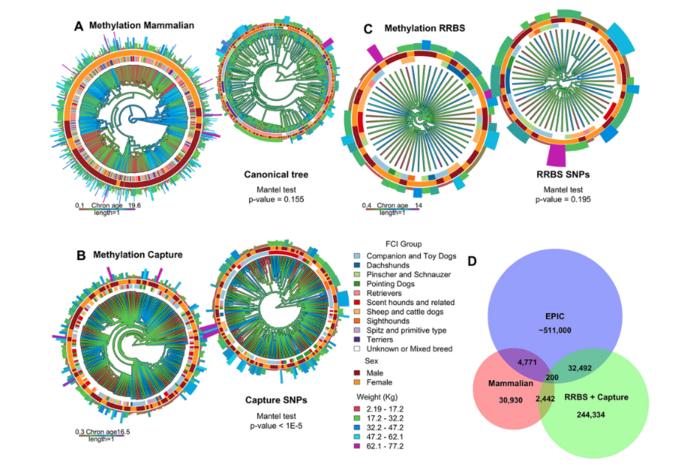“In this study, we explore the potential of the three largest, publicly available DNA methylation datasets in dogs to identify signals of biological age.”

Credit: 2024 Armero et al.
“In this study, we explore the potential of the three largest, publicly available DNA methylation datasets in dogs to identify signals of biological age.”
BUFFALO, NY- July 23, 2024 – A new research paper was published in Aging (listed by MEDLINE/PubMed as “Aging (Albany NY)” and “Aging-US” by Web of Science) Volume 16, Issue 13, entitled, “Co-analysis of methylation platforms for signatures of biological aging in the domestic dog reveals previously unexplored confounding factors.”
Chronological age reveals the number of years an individual has lived since birth. By contrast, biological age varies between individuals of the same chronological age at a rate reflective of physiological decline. Differing rates of physiological decline are related to longevity and result from genetics, environment, behavior, and disease. The creation of methylation biological age predictors is a long-standing challenge in aging research due to the lack of individual pre-mortem longevity data.
In this new study, researchers Aitor Serres Armero, Reuben M. Buckley, Lajoyce Mboning, Gabriella J. Spatola, Steve Horvath, Matteo Pellegrini, and Elaine A. Ostrander from the National Human Genome Research Institute, the University of California Los Angeles, and Altos Labs ask whether dogs experience changes in their epigenetic age at a rate predicted by breed longevity.
“The consistent differences in longevity between domestic dog breeds enable the construction of biological age estimators which can, in turn, be contrasted with methylation measurements to elucidate mechanisms of biological aging.”
The researchers drew on three flagship methylation studies using distinct measurement platforms and tissues to assess the feasibility of creating biological age methylation clocks in the dog. They expanded epigenetic clock building strategies to accommodate phylogenetic relationships between individuals, thus controlling for the use of breed standard metrics. The team observed that biological age methylation clocks are affected by population stratification and require heavy parameterization to achieve effective predictions.
“Finally, we observe that methylation-related markers reflecting biological age signals are rare and do not colocalize between datasets.”
Read the full paper: DOI: https://doi.org/10.18632/aging.206012
Corresponding Author: Elaine A. Ostrander
Corresponding Email: eostrand@mail.nih.gov
Keywords: biological age, methylation, dog, lifespan, penalized regression
Click here to sign up for free Altmetric alerts about this article.
About Aging:
The journal Aging aims to promote 1) treatment of age-related diseases by slowing down aging, 2) validation of anti-aging drugs by treating age-related diseases, and 3) prevention of cancer by inhibiting aging. (Cancer and COVID-19 are age-related diseases.)
Aging is indexed by PubMed/Medline (abbreviated as “Aging (Albany NY)”), PubMed Central, Web of Science: Science Citation Index Expanded (abbreviated as “Aging‐US” and listed in the Cell Biology and Geriatrics & Gerontology categories), Scopus (abbreviated as “Aging” and listed in the Cell Biology and Aging categories), Biological Abstracts, BIOSIS Previews, EMBASE, META (Chan Zuckerberg Initiative) (2018-2022), and Dimensions (Digital Science).
Please visit our website at www.Aging-US.com and connect with us:
- X, formerly Twitter
- YouTube
- Spotify, and available wherever you listen to podcasts
Click here to subscribe to Aging publication updates.
For media inquiries, please contact media@impactjournals.com.
Aging (Aging-US) Journal Office
6666 E. Quaker Str., Suite 1
Orchard Park, NY 14127
Phone: 1-800-922-0957, option 1
###
Journal
Aging-US
Method of Research
Observational study
Subject of Research
Animals
Article Title
Co-analysis of methylation platforms for signatures of biological aging in the domestic dog reveals previously unexplored confounding factors
Article Publication Date
9-Jul-2024



